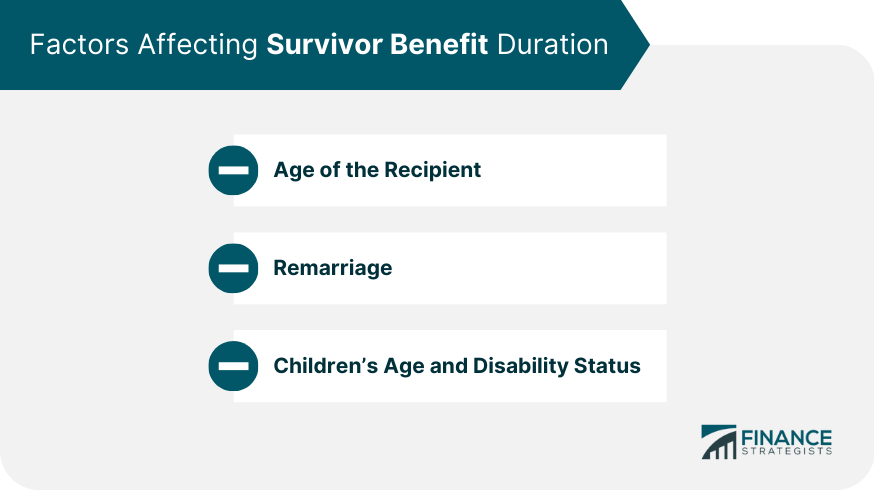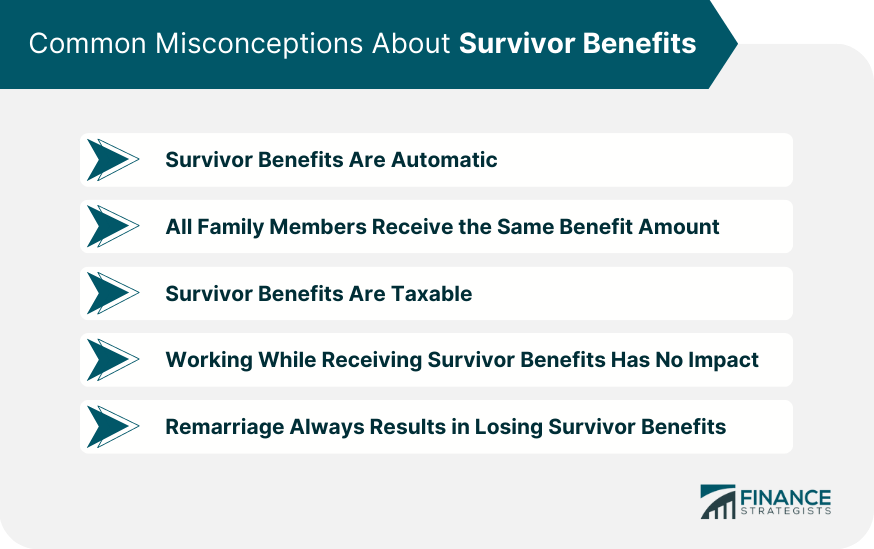Social Security Benefits for Survivors and Dependents are benefits paid by the Social Security Administration (SSA) to the surviving family members of a deceased worker. These benefits are designed to provide financial support to the surviving spouse, children, and other eligible dependents after the loss of the primary earner. The amount of survivor benefits that the family members are eligible to receive is based on the deceased worker's Social Security earnings record. Generally, the surviving spouse is eligible to receive a portion of the deceased worker's benefit amount, and the eligible children and other dependents may also receive benefits. Survivor Benefits play a crucial role in the Social Security system. These benefits provide financial support to the family members of deceased workers who have earned enough Social Security credits. Have questions about Social Security Benefits? Click here. To qualify for Survivor Benefits, the deceased worker must have earned a certain number of Social Security credits. The number of credits needed depends on the worker's age at the time of death. Generally, a worker needs 40 credits (10 years of work) to be eligible, but younger workers may qualify with fewer credits. Various family members may be eligible for Survivor Benefits, including: Widow(er) or surviving divorced spouse Minor and disabled children Parents dependent on deceased worker Other eligible dependents The Primary Insurance Amount (PIA) is the basis for calculating Survivor Benefits. PIA is determined by the deceased worker's lifetime earnings and is adjusted for inflation. The Social Security Administration uses a formula based on the worker's 35 highest-earning years to calculate PIA. Different family members may receive varying benefit amounts based on their relationship to the deceased worker: Widow(er) or surviving divorced spouse: Typically receives 100% of the worker's PIA, but this amount may be reduced if they claim the benefit before their full retirement age. Minor and disabled children: Generally receive 75% of the worker's PIA, subject to a maximum family benefit limit. Dependent parents: May receive up to 82.5% of the worker's PIA if only one parent is eligible or 75% each if both parents are eligible. Lump-sum death payment: A one-time payment of $255 may be made to the surviving spouse or eligible child. Applicants must provide the necessary documentation to claim Survivor Benefits, including: Social Security numbers for the deceased worker, applicant, and any eligible children Birth, marriage, and death certificates Tax and income documents, such as W-2 forms or self-employment tax returns Survivor Benefits cannot be applied for online. Instead, applicants must call the SSA at 1-800-772-1213 or visit their local Social Security office to schedule an appointment. After submitting the required documentation, applicants may need to follow up on their claim's status and provide additional information if requested. Survivor Benefits may continue for varying durations depending on several factors: Age of the recipient: Widow(er)s and surviving divorced spouses can receive benefits until their death, but the benefits may be reduced if claimed before full retirement age. Remarriage: Benefits may cease if the surviving spouse remarries before age 60 (or age 50 if disabled). Children's age and disability status: Benefits for children typically end at age 18 (or 19 if still in high school) but may continue for disabled children if the disability began before age 22. Survivor Benefits may be adjusted in the following ways: Cost-of-living adjustments (COLA): Benefits are adjusted annually to account for inflation, ensuring recipients maintain their purchasing power. Earnings limit and reduction of benefits: If the recipient is working and below full retirement age, their benefits may be reduced if their earnings exceed certain limits Misconceptions regarding Survivor Benefits can lead to confusion and misinformation. Addressing these misconceptions can help eligible family members better understand the system and make informed decisions about their benefits. Here are some common misconceptions: Many people believe that Survivor Benefits are automatically provided upon the death of a worker. However, this is not the case. Eligible family members must apply for these benefits, providing the necessary documentation and meeting specific criteria. Another misconception is that all eligible family members receive the same amount of Survivor Benefits. In reality, benefit amounts vary based on the relationship to the deceased worker, as well as the recipient's age and disability status. For example, widow(er)s typically receive a different benefit amount than dependent children or parents. While some recipients may need to pay taxes on their Survivor Benefits, many do not. Taxes on benefits depend on the recipient's total income and filing status. If the recipient's combined income is below a certain threshold, their benefits may not be subject to federal income tax. Some individuals think that working while receiving Survivor Benefits has no effect on their benefits. However, if a recipient is working and below their full retirement age, their benefits may be reduced if their earnings exceed certain limits. Once they reach full retirement age, there is no reduction in benefits due to earned income. While it is true that remarriage can affect Survivor Benefits, this is not always the case. If a surviving spouse remarries before age 60 (or age 50 if disabled), their benefits as a surviving spouse will cease. However, if they remarry after reaching these ages, their eligibility for Survivor Benefits will not be affected. Social Security Benefits for Survivors and Dependents provide vital financial support to the families of deceased workers. Understanding eligibility requirements, benefit calculations, and the application process is essential for those seeking to claim these benefits. It is also important to consider the duration and adjustments of Survivor Benefits and be aware of common misconceptions. Gaining a comprehensive understanding of Survivor Benefits can help eligible family members navigate the Social Security system more effectively and ensure they receive the financial support they are entitled to. It is crucial to stay informed and consult reliable sources for accurate information and guidance. For more information on Survivor Benefits and assistance with the application process, individuals can visit the official Social Security Administration website at www.ssa.gov or contact their local Social Security office. Additionally, financial advisors and organizations specializing in Social Security benefits can provide personalized guidance and support.What Are Social Security Benefits for Survivors and Dependents?
Eligibility for Social Security Benefits for Survivors and Dependents
Criteria for Deceased Worker's Eligibility
Eligible Family Members
Calculation of Social Security Benefits for Survivors and Dependents
Primary Insurance Amount (PIA)
Benefit Amounts for Different Family Members
Application and Claim Process for Social Security Benefits for Survivors and Dependents
Documentation Requirements
Application Procedure
Duration and Adjustments of Social Security Benefits for Survivors and Dependents
Factors Affecting Benefit Duration

Benefit Adjustments
Common Misconceptions About Survivors and Dependents Benefits
Survivor Benefits Are Automatic
All Family Members Receive the Same Benefit Amount
Survivor Benefits Are Taxable
Working While Receiving Survivor Benefits Has No Impact
Remarriage Always Results in Losing Survivor Benefits

Conclusion
Social Security Benefits for Survivors and Dependents FAQs
Survivor benefits are benefits paid to a surviving spouse, child, or dependent of a deceased worker who was eligible for Social Security benefits.
To be eligible for survivor benefits, the deceased worker must have been eligible for Social Security benefits, and the surviving spouse, child, or dependent must meet certain eligibility requirements.
The types of survivor benefits available include survivor benefits for a surviving spouse, benefits for a surviving divorced spouse, benefits for a surviving child or children, and benefits for other eligible dependents.
The amount of survivor benefits that a person is eligible to receive is based on the deceased worker's Social Security earnings record, as well as other factors such as the age and relationship of the survivor.
Yes, survivor benefits can be reduced if the survivor is also eligible for their own Social Security benefits. This is known as the "dual entitlement" rule, and it ensures that a person cannot receive both their own Social Security benefits and survivor benefits based on the same earnings record at the same time.
True Tamplin is a published author, public speaker, CEO of UpDigital, and founder of Finance Strategists.
True is a Certified Educator in Personal Finance (CEPF®), author of The Handy Financial Ratios Guide, a member of the Society for Advancing Business Editing and Writing, contributes to his financial education site, Finance Strategists, and has spoken to various financial communities such as the CFA Institute, as well as university students like his Alma mater, Biola University, where he received a bachelor of science in business and data analytics.
To learn more about True, visit his personal website or view his author profiles on Amazon, Nasdaq and Forbes.











